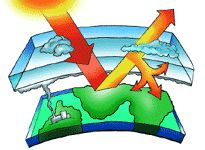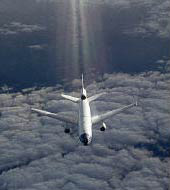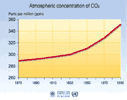 Some atmospheric gases, called greenhouse gases, trap a portion of the outgoing energy, retaining heat somewhat like the
glass panels of a greenhouse. Without this natural "greenhouse effect", temperatures would be much lower than they are now
(-15°C), and life as known today would not be possible. Instead, thanks to greenhouse gases, the earth's average
temperature is a more hospitable 15°C. However, problems may arise when the atmospheric concentration of greenhouse
gases increases by human activities
Some atmospheric gases, called greenhouse gases, trap a portion of the outgoing energy, retaining heat somewhat like the
glass panels of a greenhouse. Without this natural "greenhouse effect", temperatures would be much lower than they are now
(-15°C), and life as known today would not be possible. Instead, thanks to greenhouse gases, the earth's average
temperature is a more hospitable 15°C. However, problems may arise when the atmospheric concentration of greenhouse
gases increases by human activities
- water vapor
- carbon dioxide
- methane
- nitrous oxide, and
- ozone.
- Carbon dioxide is released to the atmosphere when solid waste, fossil fuels (oil, natural gas, and coal), and wood and wood products are burned.
- Methane emissions result from the rise production, the decomposition of organic wastes in municipal solid waste landfills, and the raising of livestock. Methane also is emitted during the production and transport of coal, natural gas, and oil.
- Nitrous oxide is emitted during agricultural and industrial activities, as well as during combustion of solid waste and fossil fuels.
- carbon dioxide (CO2) from about 280 to almost 360 ppmv3 (view graphic),
- methane (CH4) from 700 to 1720 ppbv and
- nitrous oxide (N2O) from about 275 to about 310 ppbv.
These trends can be attributed largely to human activities, mostly
- fossil-fuel use: From 1850 - 1990 212 (±21) Gt of carbon were emitted by burning fossil fuels (oil, natural gas, and coal). In 1990, the three largest sectors of energy consumption were industry (45% of total CO2 releases), residential/commercial sector (29%) and transport (21%).
- land-use change (e.g. deforestation): During the period 1850 - 1990, net cumulative global CO2 emissions from land use change are estimated to have been 124 (±50) Gt Carbon. Of these about 108 Gt C were from forest areas and about 16 Gt C from cultivation of mid-latitude grasslands. Note: agriculture ecosystems have a smaller capacity to accumulate carbon than forests (20 to 100 time less).
- agriculture: Agriculture's contribution to the enhanced greenhouse effect is 9 - 15% (e.g. methane emissions by cows).
Concentrations of other anthropogenic greenhouse gases have also increased. An increase of greenhouse gas concentrations leads on average to an additional warming of the atmosphere and the Earth's surface. Many greenhouse gases remain in the atmosphere - and affect climate - for a long time.
 Human activities (e.g. combustion of fossil fuels, biomass burning) also affect the amount of aerosol (microscopic airborne
particles) in the atmosphere which influences climate in other ways. The main direct effect of aerosols is the scattering of
some solar radiation back to space, which tends to cool the Earth's surface.
Human activities (e.g. combustion of fossil fuels, biomass burning) also affect the amount of aerosol (microscopic airborne
particles) in the atmosphere which influences climate in other ways. The main direct effect of aerosols is the scattering of
some solar radiation back to space, which tends to cool the Earth's surface.
Because human-made aerosols typically remain in the atmosphere for only a few days they tend to be concentrated near their sources such as industrial regions. The radiative forcing therefore possesses a very strong regional pattern, and the presence of aerosols adds further complexity to possible climate change as it can help mask, at least temporarily, any global warming arising from increased greenhouse gases. However, the aerosol effects do not cancel the global-scale effects of the much longer-lived greenhouse gases, and significant climate changes can still result.
Intergovernmental Panel on Climate Change (IPCC) (2000). IPCC Special Report: Land Use, Land Use Change and Forestry: Summary for Policymakers.
Intergovernmental Panel on Climate Change (IPCC) (1995). Climate change 1995: The Science of Climate Change: Contribution of Working Group I to the Second Assessment Report of the Intergovernmental Panel on Climate Change.
EPA Global Warming page
